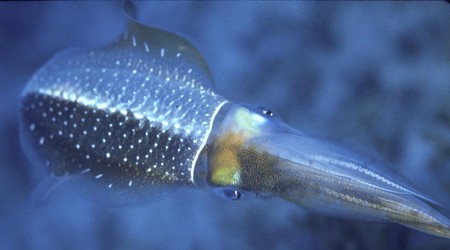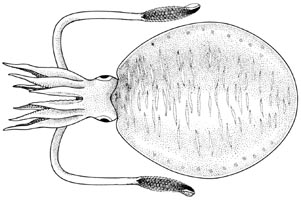Sepioteuthis
Reef squids
Michael Vecchione and Richard E. Young


This tree diagram shows the relationships between several groups of organisms.
The root of the current tree connects the organisms featured in this tree to their containing group and the rest of the Tree of Life. The basal branching point in the tree represents the ancestor of the other groups in the tree. This ancestor diversified over time into several descendent subgroups, which are represented as internal nodes and terminal taxa to the right.

You can click on the root to travel down the Tree of Life all the way to the root of all Life, and you can click on the names of descendent subgroups to travel up the Tree of Life all the way to individual species.
For more information on ToL tree formatting, please see Interpreting the Tree or Classification. To learn more about phylogenetic trees, please visit our Phylogenetic Biology pages.
close boxIntroduction
Sepioteuthis is distinctive; unlike in many loliginid genera, controversy does not exists over which species should be included (Vecchione et al., 1998). These loliginids have a rather broad, posteriorly rounded mantle and fins that extend nearly the full length of the mantle. This gives them a Sepia-like appearance. They also lay eggs that are much larger than those of other loliginids. They usually are found in shallow tropical or subtropical regions.
Brief diagnosis:
A loliginid ...
- with fins in adults that occupy >85% ML; combined fin shape broadly elliptical.
Characteristics
- Arms
- Arm sucker rings with pointed teeth around entire margin.
- Hectocotylus:
- Ventral crest absent.
- Proximal suckers unmodified.
- Distal suckers reduced, sucker stalks elongated along modified portion of arm to form papillae on both dorsal and ventral rows.
- Tentacles
- Tentacular clubs expanded, with suckers in four series.
- Tentacular clubs expanded, with suckers in four series.
- Head
- Beaks: Descriptions can be found here: Lower beak; upper beak.
- Mantle
- Posterior mantle not elongated into tail-like structure.
- Posterior mantle not elongated into tail-like structure.
- Fins
- Extend nearly full length of mantle (>85% of ML) except in very young squid.
- Photophores
- Photophores absent.
- Photophores absent.
- Viscera
- Eggs larger than 5 mm.
- Eggs lie in single, straight series within egg strand.
- Spermatophore cement body short.
Discussion of Phylogenetic Relationships
Relationships among species are uncertain. Segawa et al. (1993) suggest that S. lessioniana represents a species complex.Distribution
Because of their association with coral reefs, the common name for these species is "reef squids". The distribution of the genus generally follows that of coral reefs, warm, clear, tropical and subtropical waters, but coral reefs are not a habitat requirement for all of these squids. For example, S. lessoniana is common around the southern part of Honshu and Kyushu in Japan, but is not associated with coral reefs in those areas and occupies temperate waters of southern Australia. There is one species, S. australisS. sepioidea, in the western Atlantic; the remaining species are found in Indo-West Pacific waters.
References
Nesis, K. N. 1982. Abridged key to the cephalopod mollusks of the world's ocean. 385+ii pp. Light and Food Industry Publishing House, Moscow. (In Russian.). Translated into English by B. S. Levitov, ed. by L. A. Burgess (1987), Cephalopods of the world. T. F. H. Publications, Neptune City, NJ, 351pp.
Segawa, S., S. Hirayama and T. Okutani. 1993. Is Sepioteuthis lessoniana in Okinawa a single species? Pp. 513-521. In: T. Okutani, R. K. O'Dor and T. Kubodera (eds). Recent Advances in Cephalopod Fisheries Biology. Tokai University Press, Tokyo.
Vecchione, M., T. F. Brakoniecki, Y. Natsukari and R. T. Hanlon. 1998. A provisional generic classification of the family Loliginidae. Smithson. Contr. Zool., 586
About This Page

National Museum of Natural History, Washington, D. C. , USA

University of Hawaii, Honolulu, HI, USA
Correspondence regarding this page should be directed to Michael Vecchione at
Page copyright © 2018
 Page: Tree of Life
Sepioteuthis . Reef squids.
Authored by
Michael Vecchione and Richard E. Young.
The TEXT of this page is licensed under the
Creative Commons Attribution-NonCommercial License - Version 3.0. Note that images and other media
featured on this page are each governed by their own license, and they may or may not be available
for reuse. Click on an image or a media link to access the media data window, which provides the
relevant licensing information. For the general terms and conditions of ToL material reuse and
redistribution, please see the Tree of Life Copyright
Policies.
Page: Tree of Life
Sepioteuthis . Reef squids.
Authored by
Michael Vecchione and Richard E. Young.
The TEXT of this page is licensed under the
Creative Commons Attribution-NonCommercial License - Version 3.0. Note that images and other media
featured on this page are each governed by their own license, and they may or may not be available
for reuse. Click on an image or a media link to access the media data window, which provides the
relevant licensing information. For the general terms and conditions of ToL material reuse and
redistribution, please see the Tree of Life Copyright
Policies.
- Content changed 02 September 2010
Citing this page:
Vecchione, Michael and Richard E. Young. 2010. Sepioteuthis . Reef squids. Version 02 September 2010 (under construction). http://tolweb.org/Sepioteuthis/19862/2010.09.02 in The Tree of Life Web Project, http://tolweb.org/









 Go to quick links
Go to quick search
Go to navigation for this section of the ToL site
Go to detailed links for the ToL site
Go to quick links
Go to quick search
Go to navigation for this section of the ToL site
Go to detailed links for the ToL site